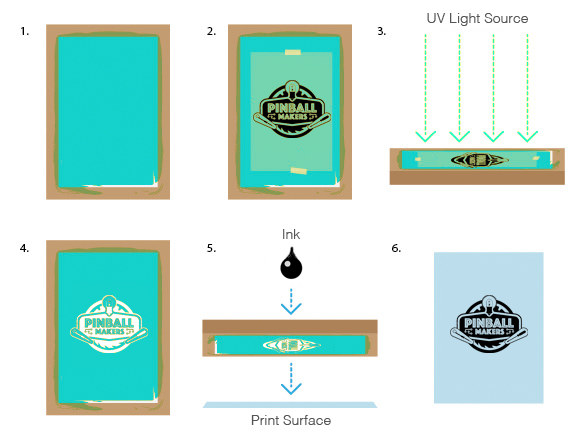Difference between revisions of "Artwork"
(→Backglass) |
(→Style) |
||
| Line 1: | Line 1: | ||
== Style == | == Style == | ||
| + | |||
| + | When constructing a game at home in a garage, the style of artwork used is not often a priority - the physical creation and development comes first. However, the single most effective draw a game has to bring players in is the backglass, playfield and cabinet artwork. | ||
| + | |||
=== Screenprint === | === Screenprint === | ||
| + | |||
| + | Until the early 1990's, the only process used in creating playfield art was screenprinting. Even today, most playfields are screenprinted, including Stern, which uses a '''four-color process''' method. | ||
| + | |||
| + | Screenprinting involves pushing ink through a specially-prepared screen unto a surface. This method is ideal for playfields as it can be done on slightly irregular surfaces, or on non-flexible surfaces easily. | ||
| + | |||
| + | The basic process is as follows: | ||
| + | |||
| + | {|style="cellpadding=10" | ||
| + | |1. The screen, which has a special mesh tightly attached to it, is coated in a UV-sensitive material and allowed to dry. | ||
| + | |rowspan=6|[[Image:screenprinting.jpg]] | ||
| + | |- | ||
| + | |2. A ''Photo Positive'' of the image to be printed is placed on the screen. It is a 'positive' because the areas in black are what is being printed, as opposed to a ''photo negative'' which has the open parts being printed. | ||
| + | |- | ||
| + | |3. The screen is exposed to UV light for a set period of time. This causes any part of the coating not covered to become hard and water resistant. | ||
| + | |- | ||
| + | |4. The exposed screen is washed out with a hose, which removes the unexposed coating but leaves the exposed coating. | ||
| + | |- | ||
| + | |5. Ink is placed on the screen and, using a squeegee, is drawn across the screen. Any open areas in the screen allow the ink through unto the printing surface. | ||
| + | |- | ||
| + | |6. The final printed surface with the image. | ||
| + | |} | ||
| + | |||
=== Photorealistic === | === Photorealistic === | ||
Revision as of 16:03, 12 January 2015
Contents
Style
When constructing a game at home in a garage, the style of artwork used is not often a priority - the physical creation and development comes first. However, the single most effective draw a game has to bring players in is the backglass, playfield and cabinet artwork.
Screenprint
Until the early 1990's, the only process used in creating playfield art was screenprinting. Even today, most playfields are screenprinted, including Stern, which uses a four-color process method.
Screenprinting involves pushing ink through a specially-prepared screen unto a surface. This method is ideal for playfields as it can be done on slightly irregular surfaces, or on non-flexible surfaces easily.
The basic process is as follows:
Photorealistic
Printing
All commercial playfields are direct printed using ink. Some users opt to print on vinyl or mylar with adhesive, then overlay it on the playfield. Either the insert locations are trimmed away, or it's printed clear with the insert artwork already included. Printing white on clear media is sometimes a challenge.
Playfield
Graphics are often outlined heavy so they show up.
Backglass
Back in EM and carried over to solid state days, the scores were embedded in with the art. Towards the mid 80's, the numeric scoring was moved down between the speakers, which eventually became alphanumeric, and then DMD. Separating the scoring from the art simplifies things, and ensures the art doesn't need to be compromised by the displays poking through. Usually the name of the game is included somewhere in the artwork, but not always. Titles like Whitewater and Adams family are simply art.
Cabinet
While there have been a few odd cabinet shapes and widths (gottlieb did some funky backboxes, Atari had some super wide-bodies), most custom projects use the standard and widebody from Williams. The backbox of a williams typically has a deeper top and narrow bottom to match the angle of the lower cabinet so it sits flush and flat when folded. Stern has done a similar design for years, but has recently switched to a square backbox with T-molding, as well as a new tilted DMD bezel that is tilted back to minimize reflection on the glass.
Typically the cabinet will have the name of the machine, often as a logo. Sometimes the art is printed with a plain background, sometimes the entire cabinet is filled with art. Like playfields, the cabinet can be direct printing or decaled . Stern has been doing decals for many years now because they can get brighter printing colors that pop compared to direct print.
Graphics
Numeric / Alphanumeric
Numeric and Alphanumeric are sometimes chosen even today because of the ease of programming. Creating dots for DMD animation can take a lot of time.

